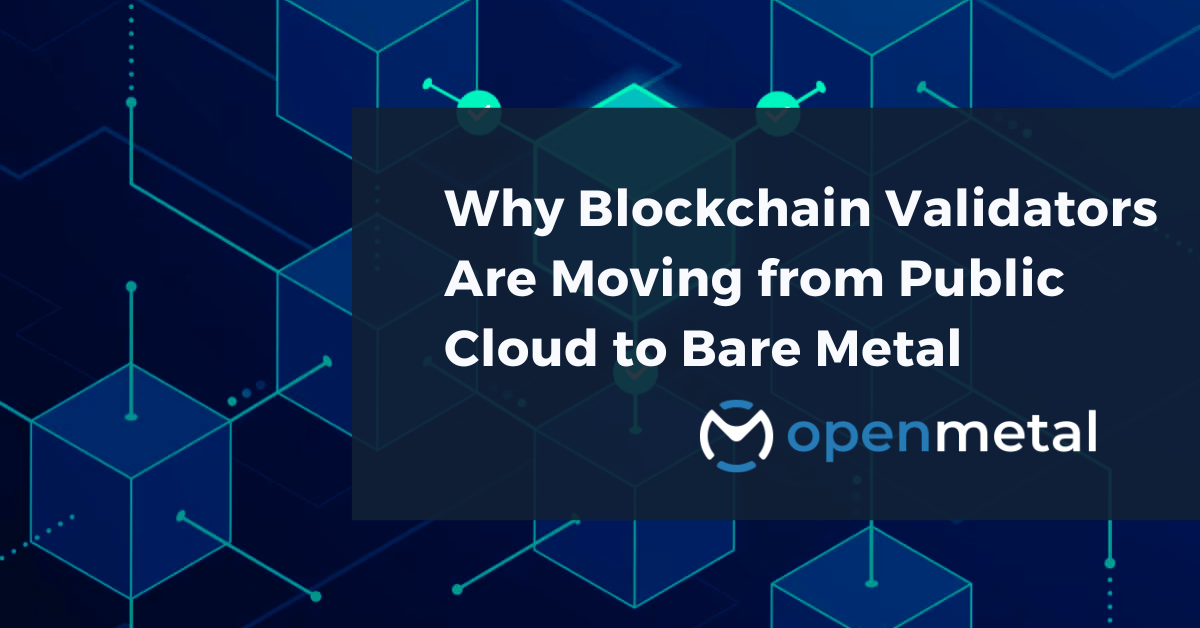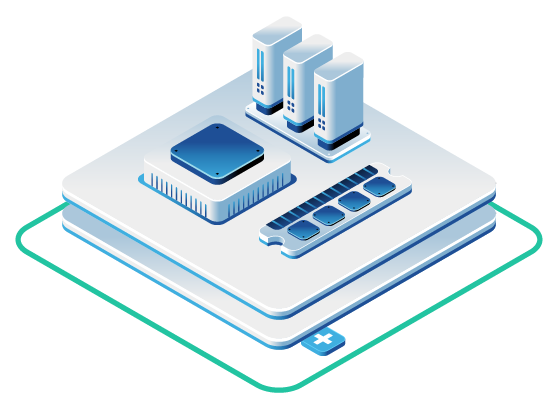
Running blockchain validators on public cloud infrastructure might seem like the path of least resistance, but validator operators are discovering the hard way that hyperscale platforms weren’t designed for their workloads. When consensus mechanisms demand millisecond precision, when state data grows into terabytes, and when network spikes can triple your monthly bill, the limitations of shared cloud environments become impossible to ignore. Validator operators are moving to bare metal infrastructure, and the reasons go far beyond simple cost savings—this shift reflects fundamental incompatibilities between how public clouds allocate resources and what blockchain protocols actually require.
The Validator Performance Problem
Blockchain validators face a unique set of technical demands. Unlike typical web applications that can tolerate occasional latency spikes or brief periods of reduced throughput, validators participate in consensus mechanisms where timing is everything. Miss a block proposal window by a few hundred milliseconds, and your validator loses rewards. Experience throttling during a transaction surge, and your node might fall out of sync with the network.
Public cloud infrastructure operates on a multi-tenant model where multiple customers share the same physical hardware. This works well for many applications, but validators running on shared infrastructure encounter the “noisy neighbor” problem—when another tenant on the same physical server suddenly demands more resources, your validator workload gets throttled.
The issue becomes particularly apparent during network events. When a blockchain experiences high transaction volume or goes through a protocol upgrade, validators need maximum compute and network capacity simultaneously. Public cloud platforms often throttle both CPU and network I/O during exactly these moments, when shared resources are under the heaviest demand across multiple tenants.
Dedicated Hardware Eliminates Resource Contention
Bare metal servers address the noisy neighbor problem by giving validator operators dedicated physical hardware. Each server runs only the customer’s workloads, with no resource sharing or throttling. When you select a configuration like the Medium V4 with 24 cores and 48 threads, the Large V4 with 32 cores and 64 threads, or higher-capacity XL V4 systems with up to 128 threads and terabytes of DDR5 memory, those resources are yours exclusively.
This matters most when validators need consistent performance. In bare metal environments, CPU cycles aren’t shared, memory bandwidth remains constant, and there’s no hypervisor overhead consuming resources. Validators can run at peak capacity during consensus operations without worrying about sudden performance drops caused by other tenants.
Enterprise-grade hardware configurations also include high-performance Micron NVMe drives for state storage. These drives deliver the consistent read and write speeds validators need when accessing blockchain state data, without the IOPS limitations or burst credit systems common in cloud storage solutions.
Networking: The Critical Performance Factor
Network performance determines how quickly validators can communicate with peers, propagate blocks, and participate in consensus. This is where bare metal infrastructure shows particularly clear advantages over public cloud environments.
Every OpenMetal server includes dual 10 Gbps NICs, providing 20 Gbps of private networking capacity and 20 Gbps of public uplink. Within deployments, customers receive isolated VLANs with unmetered traffic between nodes. This setup supports fast peer-to-peer communication between validators and ensures performance remains consistent during spikes in consensus or transaction load.
Compare this to public cloud networking, where bandwidth is often shared, metered, and subject to throttling during periods of high utilization. Blockchain networks like Solana validate blocks in milliseconds and depend on rapid data propagation across validator nodes. Any network delay—whether from throttling, congestion, or routing inefficiencies—directly impacts a validator’s ability to participate in consensus and earn rewards.
Public networking on bare metal servers includes DDoS protection and the option to bring your own IP blocks. This routing flexibility matters for operators who need specific network configurations or want to maintain consistent IP addresses across infrastructure changes. For validators running BGP routing or requiring Layer 2 network access, bare metal provides direct hardware control that virtualized environments simply cannot match.
Storage Requirements for Growing Chain State
Blockchain state data presents unique storage challenges. Unlike databases that can archive old records or applications that work primarily with recently created data, blockchain validators must maintain access to continuously growing state information. This data must be retrieved quickly during consensus operations and remain available without interruption.
Integrating Ceph storage clusters into validator infrastructure provides consistent, scalable performance without the limitations of cloud-based block storage. Ceph’s distributed architecture ensures that validator nodes can maintain chain data integrity even under heavy load, with no burst credit limitations or IOPS throttling.
Public cloud storage services typically use credit-based systems where storage performance degrades after consuming allocated burst credits. For validators processing high transaction volumes or handling protocol upgrades that require intensive disk operations, these limitations create operational risks. State data must be accessible when consensus requires it—not after waiting for burst credits to replenish.
The scalability of Ceph storage matters as blockchains grow. State data for active networks increases continuously, and validators must store this information reliably while maintaining quick access. Ceph scales horizontally by adding storage nodes to clusters, allowing capacity to grow alongside network requirements without performance degradation.
Predictable Costs vs. Usage-Based Metering
Public cloud billing becomes unpredictable when validators experience network activity spikes. Usage-based metering means that increases in transaction volume, protocol upgrades, or network events can suddenly multiply compute and egress costs. For operators running validators on high-throughput blockchains or protocols with frequent updates, this variability represents a major operational risk.
Bare metal pricing is based on dedicated hardware capacity, not usage-based metering. Validator operators pay a fixed rate for their server configuration and storage infrastructure, regardless of how intensively they use the resources. When network activity increases, costs remain constant.
This predictability extends to data transfer. While public clouds often charge high egress fees for data leaving their networks, bare metal providers typically include substantial bandwidth allocations or use more favorable pricing models. For validators that must sync state data, communicate with peer nodes, and propagate blocks across networks, these bandwidth costs add up quickly in public cloud environments.
The financial benefits become particularly clear for organizations running multiple validators across different blockchain networks. Each validator’s resource requirements differ, but the total infrastructure cost remains predictable regardless of fluctuations in network activity or transaction volumes.
Security Features for Sensitive Workloads
Blockchain protocols increasingly require validators to handle sensitive data, from transaction details to governance information. Security features built into modern bare metal servers address these requirements with hardware-level protection.
Intel Trust Domain Extensions (TDX) and Software Guard Extensions (SGX) provide confidential computing capabilities, including isolated virtualized environments, remote attestation, and secure boot processes. These technologies create encrypted execution environments where even the server operator cannot access the data being processed. For protocols requiring validators to maintain confidentiality while participating in consensus, these features are increasingly non-negotiable.
TPMv2 (Trusted Platform Module version 2) hardware provides secure key storage and hardware-level encryption support. This allows validators to protect private keys and sensitive configuration data with hardware-backed security, reducing the risk of key compromise even if server access is breached.
Single-tenant environments also reduce attack surfaces. In multi-tenant cloud environments, vulnerabilities in the hypervisor or neighboring tenants potentially create security risks. Bare metal servers eliminate these concerns by providing complete isolation at the hardware level.
Deployment Speed and Operational Flexibility
Validator operators often need to deploy new infrastructure quickly—whether launching nodes for a testnet, scaling capacity during mainnet growth, or replacing failed servers. The time required to provision production-ready infrastructure directly impacts operational efficiency.
OpenMetal’s automation provisions a production-ready hosted private cloud environment in approximately 45 seconds, with the ability to add additional servers in about 20 minutes. This deployment speed enables validator operators to respond rapidly to changing requirements without the delays typical of traditional hardware procurement or lengthy cloud provisioning processes.
The flexibility extends to infrastructure management. Operators can configure networking, storage, and compute resources to match specific validator requirements rather than adapting their workloads to fit preset cloud configurations. Need BGP routing? Layer 2 network access? Custom storage configurations? Bare metal infrastructure provides the control to implement exactly what your validators need.
This flexibility also supports the hybrid and multi-region strategies that many validator operators employ. Running validators across geographically distributed locations improves network redundancy and reduces latency to different peer populations. OpenMetal operates data centers in Los Angeles, Virginia, Amsterdam, and Singapore, offering validators global distribution options to improve uptime and reduce latency to major blockchain network hubs.
The Web3 Infrastructure Shift
The movement from public cloud to bare metal isn’t limited to individual validator operators. Entire Web3 infrastructure companies are making the transition as they recognize that public cloud platforms weren’t architected for blockchain workloads.
One Web3 infrastructure company developing Layer 1 blockchain technology and decentralized storage systems reduced infrastructure costs by 30% after moving to bare metal, while maintaining the flexibility and control needed to scale their services. By deploying across multiple data center locations, they improved global availability and network performance for their validators and storage nodes.
A crypto trading firm running Solana validator operations deployed XL V4 bare metal servers to support high-memory, low-latency workloads. The dedicated hardware environment eliminated noisy neighbor issues and allowed them to fine-tune system performance for polling-mode operations and algorithmic trading. The infrastructure also provided the networking control necessary for BGP routing and future high-bandwidth API workloads.
For blockchain research organizations working on MEV protection and block production infrastructure, bare metal servers with Intel SGX and TDX capabilities provided the confidential computing features required for their secure enclave testing. The flexibility to access BIOS settings and configure hardware-level security features isn’t typically available in public cloud environments.
When Public Cloud Makes Sense—And When It Doesn’t
Public cloud infrastructure serves many use cases well. For applications with variable workloads, infrequent usage, or requirements for rapid geographical expansion across dozens of regions, cloud platforms offer clear advantages. Development and testing environments often benefit from cloud flexibility and pay-per-use billing.
Blockchain validators, however, represent a different category of workload. They require:
- Consistent, unthrottled performance 24/7
- High network bandwidth without usage penalties
- Rapidly growing storage that must remain performant
- Predictable operational costs
- Hardware-level security features
- Direct control over networking and system configuration
These requirements align poorly with the multi-tenant, usage-metered, virtualized model that defines public cloud infrastructure. The question isn’t whether public clouds are good or bad—it’s whether their design matches what validators actually need.
For most production validator workloads, the answer is increasingly clear. Bare metal infrastructure provides the performance consistency, cost predictability, and operational control that validators require. The migration from public cloud to bare metal reflects validator operators making pragmatic choices based on their actual requirements rather than following conventional wisdom about where to run infrastructure.
Making the Transition
Moving validator infrastructure from public cloud to bare metal requires planning, but the operational and financial benefits justify the effort. Start by assessing your current validator performance metrics—block proposal success rates, sync times, network latency, and monthly infrastructure costs. These baseline measurements help you understand what’s working and what needs improvement.
Consider your storage requirements carefully. State data will continue growing, so plan for both current capacity and future expansion. Ceph storage clusters provide the scalability validators need without the capacity planning challenges of fixed-size cloud volumes.
Evaluate geographical requirements based on your validator’s peer connections. If your validators primarily communicate with nodes in specific regions, selecting data center locations that minimize latency to those peers improves consensus participation. For networks with globally distributed validators, consider multi-region deployments to maintain strong connectivity regardless of peer location.
Test configurations in non-production environments first. Deploy testnet validators on bare metal infrastructure to verify performance, tune networking settings, and validate your migration process before moving mainnet operations. This approach reduces risk and helps you understand the operational characteristics of your new infrastructure.
Document the performance and cost improvements you observe during migration. Track metrics like block proposal success rates, sync times, network throughput, and monthly infrastructure costs. These measurements demonstrate the tangible benefits of bare metal infrastructure and inform future infrastructure decisions as your validator operations scale.
Infrastructure That Matches Validator Requirements
Blockchain validators operate under constraints that make them fundamentally incompatible with public cloud infrastructure. The performance consistency they require conflicts with multi-tenant resource sharing. The bandwidth they consume becomes prohibitively expensive under usage-based billing. The storage they need grows continuously while public cloud performance degrades.
Bare metal infrastructure aligns with these requirements rather than fighting against them. Dedicated hardware eliminates resource contention. Fixed pricing removes cost unpredictability. Scalable storage grows alongside chain state. Hardware security features protect sensitive validator operations.
The validators moving to bare metal aren’t making a philosophical statement about decentralization or avoiding corporate cloud providers. They’re choosing infrastructure that actually supports their operational requirements. When consensus happens in milliseconds and performance gaps mean lost rewards, the choice becomes straightforward.
Your validators demand infrastructure built for their specific needs—consistent performance, predictable costs, and operational control. That’s exactly what bare metal delivers.
Read More on the OpenMetal Blog


































